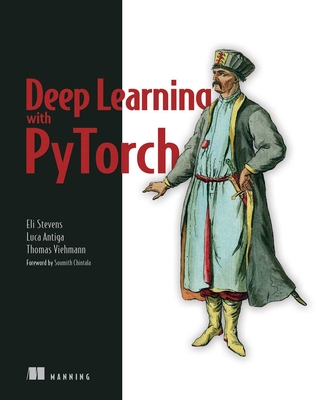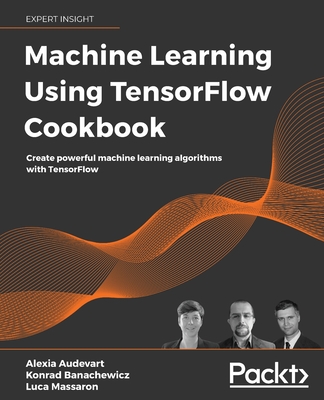Python Machine Learning: Machine Learning and Deep Learning with Python, scikit-learn, and TensorFlow 2, 3/e (Paperback)
暫譯: Python 機器學習:使用 Python、scikit-learn 和 TensorFlow 2 的機器學習與深度學習,第 3 版(平裝本)
Sebastian Raschka, Vahid Mirjalili
- 出版商: Packt Publishing
- 出版日期: 2019-12-09
- 售價: $1,980
- 貴賓價: 9.5 折 $1,881
- 語言: 英文
- 頁數: 748
- ISBN: 1789955750
- ISBN-13: 9781789955750
-
相關分類:
Machine Learning、DeepLearning、TensorFlow
-
相關翻譯:
Python 機器學習 (上), 3/e (Python Machine Learning: Machine Learning and Deep Learning with Python, scikit-learn, and TensorFlow, 3/e) (繁中版)
Python 機器學習 (下), 3/e (Python Machine Learning: Machine Learning and Deep Learning with Python, scikit-learn, and TensorFlow, 3/e) (繁中版)
Python 機器學習, 3/e (Python Machine Learning: Machine Learning and Deep Learning with Python, scikit-learn, and TensorFlow 2, 3/e) (簡中版)
立即出貨 (庫存=1)
買這商品的人也買了...
-
 Fundamentals of Data Structures in C++, 2/e (Paperback)
Fundamentals of Data Structures in C++, 2/e (Paperback)$1,390$1,362 -
 $3,325The Elements of Statistical Learning: Data Mining, Inference, and Prediction, 2/e (Hardcover)
$3,325The Elements of Statistical Learning: Data Mining, Inference, and Prediction, 2/e (Hardcover) -
 $1,680An Introduction to Statistical Learning: With Applications in R (Hardcover)
$1,680An Introduction to Statistical Learning: With Applications in R (Hardcover) -
 Neural Network Design, 2/e (Paperback)
Neural Network Design, 2/e (Paperback)$1,650$1,617 -
 Statistical Methods for Recommender Systems(Hardcover)
Statistical Methods for Recommender Systems(Hardcover)$2,200$2,090 -
 $1,617Deep Learning (Hardcover)
$1,617Deep Learning (Hardcover) -
 Deep Learning with Python (Paperback)
Deep Learning with Python (Paperback)$1,790$1,701 -
 Practical Industrial Internet of Things Security: A practitioner's guide to securing connected industries
Practical Industrial Internet of Things Security: A practitioner's guide to securing connected industries$1,640$1,558 -
 Hands-On Machine Learning with Scikit-Learn, Keras, and TensorFlow, 2/e (Paperback)
Hands-On Machine Learning with Scikit-Learn, Keras, and TensorFlow, 2/e (Paperback)$2,560$2,432 -
 Click Here to Kill Everybody: Security and Survival in a Hyper-connected World
Click Here to Kill Everybody: Security and Survival in a Hyper-connected World$1,200$1,140 -
 The Hundred-Page Machine Learning Book (Hardcover)
The Hundred-Page Machine Learning Book (Hardcover)$2,030$1,929 -
 Introduction to Data Mining, 2/e (GE-Paperback)
Introduction to Data Mining, 2/e (GE-Paperback)$1,420$1,392 -
 Python 技術者們 - 練功!老手帶路教你精通正宗 Python 程式 (The Quick Python Book, 3/e)
Python 技術者們 - 練功!老手帶路教你精通正宗 Python 程式 (The Quick Python Book, 3/e)$780$663 -
 $1,080Deep Learning with Pytorch (Paperback)
$1,080Deep Learning with Pytorch (Paperback) -
 $1,938Building Machine Learning Powered Applications: Going from Idea to Product
$1,938Building Machine Learning Powered Applications: Going from Idea to Product -
 $1,788Deep Reinforcement Learning Hands-On, 2/e (Paperback)
$1,788Deep Reinforcement Learning Hands-On, 2/e (Paperback) -
 計算機視覺中的多視圖幾何, 2/e (Multiple View Geometry in Computer Vision, 2/e)
計算機視覺中的多視圖幾何, 2/e (Multiple View Geometry in Computer Vision, 2/e)$1,014$963 -
 Introduction to Machine Learning, 4/e (Hardcover)
Introduction to Machine Learning, 4/e (Hardcover)$1,690$1,656 -
 精通機器學習|使用 Scikit-Learn , Keras 與 TensorFlow, 2/e (Hands-on Machine Learning with Scikit-Learn, Keras, and TensorFlow, 2/e)
精通機器學習|使用 Scikit-Learn , Keras 與 TensorFlow, 2/e (Hands-on Machine Learning with Scikit-Learn, Keras, and TensorFlow, 2/e)$1,200$948 -
 Mathematics for Machine Learning (Paperback)
Mathematics for Machine Learning (Paperback)$1,520$1,490 -
 深度學習的數學地圖 -- 用 Python 實作神經網路的數學模型 (附數學快查學習地圖)
深度學習的數學地圖 -- 用 Python 實作神經網路的數學模型 (附數學快查學習地圖)$580$493 -
 GAN 對抗式生成網路 (GANs in Action: Deep learning with Generative Adversarial Networks)
GAN 對抗式生成網路 (GANs in Action: Deep learning with Generative Adversarial Networks)$750$593 -
 Python 機器學習 (上), 3/e (Python Machine Learning: Machine Learning and Deep Learning with Python, scikit-learn, and TensorFlow, 3/e)
Python 機器學習 (上), 3/e (Python Machine Learning: Machine Learning and Deep Learning with Python, scikit-learn, and TensorFlow, 3/e)$620$484 -
 Python 機器學習 (下), 3/e (Python Machine Learning: Machine Learning and Deep Learning with Python, scikit-learn, and TensorFlow, 3/e)
Python 機器學習 (下), 3/e (Python Machine Learning: Machine Learning and Deep Learning with Python, scikit-learn, and TensorFlow, 3/e)$520$406 -
 Actuarial Mathematics for Life Contingent Risks, 3/e (Hardcover)
Actuarial Mathematics for Life Contingent Risks, 3/e (Hardcover)$1,380$1,352
相關主題
商品描述
Key Features
- Third edition of the bestselling, widely acclaimed Python machine learning book
- Clear and intuitive explanations take you deep into the theory and practice of Python machine learning
- Fully updated and expanded to cover TensorFlow 2, Generative Adversarial Network models, reinforcement learning, and best practices
Book Description
Python Machine Learning, Third Edition is a comprehensive guide to machine learning and deep learning with Python. It acts as both a step-by-step tutorial, and a reference you'll keep coming back to as you build your machine learning systems.
Packed with clear explanations, visualizations, and working examples, the book covers all the essential machine learning techniques in depth. While some books teach you only to follow instructions, with this machine learning book, Raschka and Mirjalili teach the principles behind machine learning, allowing you to build models and applications for yourself.
Updated for TensorFlow 2.0, this new third edition introduces readers to its new Keras API features, as well as the latest additions to scikit-learn. It's also expanded to cover cutting-edge reinforcement learning techniques based on deep learning, as well as an introduction to GANs. Finally, this book also explores a subfield of natural language processing (NLP) called sentiment analysis, helping you learn how to use machine learning algorithms to classify documents.
This book is your companion to machine learning with Python, whether you're a Python developer new to machine learning or want to deepen your knowledge of the latest developments.
What you will learn
- Master the frameworks, models, and techniques that enable machines to 'learn' from data
- Use scikit-learn for machine learning and TensorFlow for deep learning
- Apply machine learning to image classification, sentiment analysis, intelligent web applications, and more
- Build and train neural networks, GANs, and other models
- Discover best practices for evaluating and tuning models
- Predict continuous target outcomes using regression analysis
- Dig deeper into textual and social media data using sentiment analysis
Who This Book Is For
If you know some Python and you want to use machine learning and deep learning, pick up this book. Whether you want to start from scratch or extend your machine learning knowledge, this is an essential resource. Written for developers and data scientists who want to create practical machine learning and deep learning code, this book is ideal for anyone who wants to teach computers how to learn from data.
商品描述(中文翻譯)
**主要特點**
- 第三版的暢銷、廣受好評的 Python 機器學習書籍
- 清晰且直觀的解釋深入探討 Python 機器學習的理論與實踐
- 完全更新並擴展,涵蓋 TensorFlow 2、生成對抗網路模型、強化學習及最佳實踐
**書籍描述**
《Python 機器學習》第三版是一本關於使用 Python 進行機器學習和深度學習的綜合指南。它既是逐步教程,也是您在構建機器學習系統時會不斷參考的資料。
本書充滿清晰的解釋、可視化和實作範例,深入涵蓋所有基本的機器學習技術。雖然有些書籍僅教您遵循指示,但這本機器學習書籍的作者 Raschka 和 Mirjalili 教授了機器學習背後的原則,使您能夠自行構建模型和應用程式。
本書已更新至 TensorFlow 2.0,這一新版介紹了其新的 Keras API 特性,以及 scikit-learn 的最新增強功能。它還擴展了基於深度學習的前沿強化學習技術,以及生成對抗網路(GANs)的介紹。最後,本書還探討了一個自然語言處理(NLP)的子領域——情感分析,幫助您學習如何使用機器學習算法來分類文檔。
無論您是剛接觸機器學習的 Python 開發者,還是想深入了解最新發展的讀者,這本書都是您學習 Python 機器學習的好夥伴。
**您將學到的內容**
- 精通使機器能夠從數據中「學習」的框架、模型和技術
- 使用 scikit-learn 進行機器學習,使用 TensorFlow 進行深度學習
- 將機器學習應用於圖像分類、情感分析、智能網頁應用等
- 構建和訓練神經網絡、GANs 和其他模型
- 發現評估和調整模型的最佳實踐
- 使用回歸分析預測連續目標結果
- 通過情感分析深入挖掘文本和社交媒體數據
**本書適合誰**
如果您對 Python 有一定了解,並希望使用機器學習和深度學習,這本書非常適合您。無論您是想從零開始,還是擴展您的機器學習知識,這都是一本必備資源。本書專為希望創建實用機器學習和深度學習代碼的開發者和數據科學家而寫,適合任何希望教會計算機如何從數據中學習的人。
作者簡介
Sebastian Raschka is an Assistant Professor of Statistics at the University of Wisconsin-Madison focusing on machine learning and deep learning research. Some of his recent research methods have been applied to solving problems in the field of biometrics for imparting privacy to face images. Other research focus areas include the development of methods related to model evaluation in machine learning, deep learning for ordinal targets, and applications of machine learning to computational biology.
Vahid Mirjalili obtained his Ph.D. in mechanical engineering working on novel methods for large-scale, computational simulations of molecular structures. Currently, he is focusing his research efforts on applications of machine learning in various computer vision projects at the Department of Computer Science and Engineering at Michigan State University. He recently joined 3M Company as a research scientist, where he uses his expertise and applies state-of-the-art machine learning and deep learning techniques to solve real-world problems in various applications to make life better.
作者簡介(中文翻譯)
塞巴斯蒂安·拉施卡是威斯康辛大學麥迪遜分校的統計學助理教授,專注於機器學習和深度學習研究。他最近的一些研究方法已應用於解決生物識別領域中的問題,以保護面部圖像的隱私。其他研究重點包括與機器學習中的模型評估相關的方法開發、針對序數目標的深度學習,以及機器學習在計算生物學中的應用。
瓦希德·米爾賈利利獲得了機械工程博士學位,研究大型計算模擬分子結構的新方法。目前,他專注於在密歇根州立大學計算機科學與工程系的各種計算機視覺項目中應用機器學習。他最近加入了3M公司,擔任研究科學家,利用他的專業知識,應用最先進的機器學習和深度學習技術,解決各種應用中的現實問題,以改善人們的生活。
目錄大綱
Table of Contents
- Giving Computers the Ability to Learn from Data
- Training Simple ML Algorithms for Classification
- ML Classifiers Using scikit-learn
- Building Good Training Datasets - Data Preprocessing
- Compressing Data via Dimensionality Reduction
- Best Practices for Model Evaluation and Hyperparameter Tuning
- Combining Different Models for Ensemble Learning
- Applying ML to Sentiment Analysis
- Embedding a ML Model into a Web Application
- Predicting Continuous Target Variables with Regression Analysis
- Working with Unlabeled Data - Clustering Analysis
- Implementing Multilayer Artificial Neural Networks
- Parallelizing Neural Network Training with TensorFlow
- TensorFlow Mechanics
- Classifying Images with Deep Convolutional Neural Networks
- Modeling Sequential Data Using Recurrent Neural Networks
- GANs for Synthesizing New Data
- RL for Decision Making in Complex Environments
目錄大綱(中文翻譯)
Table of Contents
- Giving Computers the Ability to Learn from Data
- Training Simple ML Algorithms for Classification
- ML Classifiers Using scikit-learn
- Building Good Training Datasets - Data Preprocessing
- Compressing Data via Dimensionality Reduction
- Best Practices for Model Evaluation and Hyperparameter Tuning
- Combining Different Models for Ensemble Learning
- Applying ML to Sentiment Analysis
- Embedding a ML Model into a Web Application
- Predicting Continuous Target Variables with Regression Analysis
- Working with Unlabeled Data - Clustering Analysis
- Implementing Multilayer Artificial Neural Networks
- Parallelizing Neural Network Training with TensorFlow
- TensorFlow Mechanics
- Classifying Images with Deep Convolutional Neural Networks
- Modeling Sequential Data Using Recurrent Neural Networks
- GANs for Synthesizing New Data
- RL for Decision Making in Complex Environments












